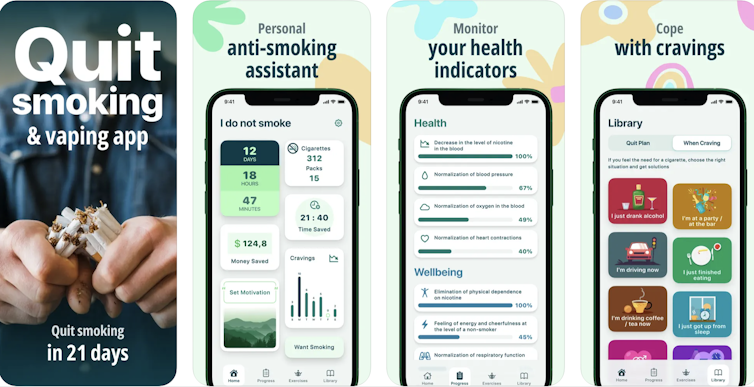More Australians than ever are smoking cigarettes, according to recently released figures.
The National Drug Strategy household survey shows that the proportion of Australians aged 14 and over who say they currently drink in 2022-2023 is 7%. In 2019, it amounted to only 2.5 percent. Users are most likely between the ages of 18 and 24.
As we learn more about the possible harms of smoking, many will want to quit smoking.
But since vaping has only become widespread in recent years, there is little evidence on how to quit smoking. Along with the addictive nature of nicotine-containing vapes, it can also be difficult to quit smoking on your own.
Could apps be the answer? The vast majority of young people have a smartphone. And we know that apps have helped people quit smoking. So why not use apps to help people quit smoking cigarettes?
But which apps are the best? And what app features should you look for? Our recently published study gives us some clues.
Read more: Can messages from social media influencers stop young people from smoking? A look at the new government campaign
We tested 30 applications
In May 2023, we searched the Apple iTunes and Google Play stores to identify apps available in Australia that claim to help people quit smoking.
We then shortlisted 20 iOS apps and ten Android apps to evaluate:
-
quality (including ease of use, the way it engages users, the way it looks and the information it conveys)
-
potential for behavior change (including setting goals, creating an action plan, identifying barriers, monitoring progress and providing feedback).
Read more: My teenager is addicted to vaping. How can I help them quit smoking and manage withdrawal symptoms?
Here’s what we found
The top rated app overall was the Quit Smoking iOS app. Stop the vaping app. This had 19 of the 21 features known to help people change behaviour.
The top-rated Android app was Quit Tracker: Stop Smoking, with 15 behavior change features.
The top rated app for Android and iOS users was the QuitSure Quit Smoking Smartly app. This had 15 behavior change features for iOS users and 14 for Android users.

Read more: My teenager cigars. What do I say? 3 expert tips on how to approach ‘the conversation’
So what should I be looking for?
There are key features of the app that could help you change your behavior. These features also apply to apps that help people stop drinking alcohol or, for example, exercise more. These features include:
-
full adaptabilityallowing individuals to customize the application to their needs
-
setting goals, allowing individuals to create their own goals, track their progress, and then update them over time. This is more likely to lead to positive behavior change
-
external helpallowing users to access more help or advice, directly from the app
-
applications that are easy to use or navigation, so users are more likely to stick with the app.
But not all the apps we evaluated scored highly. On average, the apps had only about nine of the 21 behavior change features. And only 12 of the 30 apps included a goal-setting feature.
The overall quality of the applications was moderate – with a rating of around three out of five. While the apps were easy to use and navigate, we found that they weren’t always transparent about who funded or developed them.
Read more: How apps and influencers are changing the way we sleep, for better or worse
Future applications
Previous research shows that smoking cessation apps have a higher rate of potential for behavior change than smoking cessation apps.
In one study, researchers found that more than half of users of a quit smoking app were still not smoking after one month.
Thus, app developers could look at smoking cessation apps to identify strategies and features for developing or updating smoking cessation apps.
App developers need to create apps with comprehensive goal setting features. These applications should be tried or tested by the developer, users, or an outside party. This is important because, as far as we know, no publicly available application has passed such testing.
As many young people drink to relieve stress or anxiety, future apps could provide additional features, such as meditation, cognitive behavioral therapy and relaxation.
Apps need to align with current smoking cessation guidelines so that evidence-based messages are consistent. Unfortunately, information and guidance on smoking cessation is still in its infancy and varies across countries or jurisdictions.
Developers must also disclose who owns and paid for the app. Is it a commercial company, research group, government agency, or non-profit organization? It was hard for us to tell during our analysis.
Last but not least, vaping cessation apps need to be updated and improved over time, to debug, improve as the evidence changes, and to respond to changes in user behavior.
In an ideal world, we’d see partnerships between app developers, vapers, researchers and behavioral health experts evolve to develop and update vaping cessation apps – the ones with the best chance of actually changing people’s behavior.
We would like to thank Lilian Chan, Rebecca Cerio, Sandra Rickards, Phillipa Hastings, Kate Reakes and Tracey O’Brien from the NSW Cancer Institute for their assistance with this research.